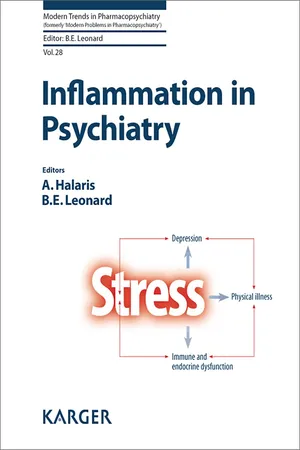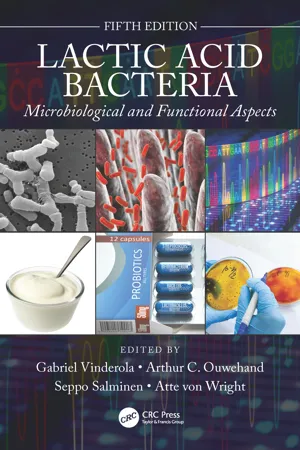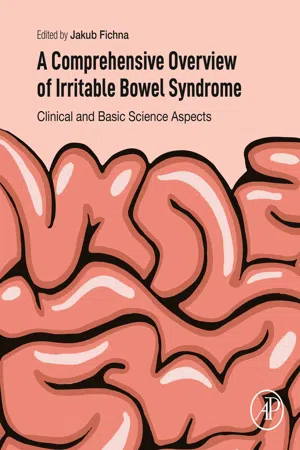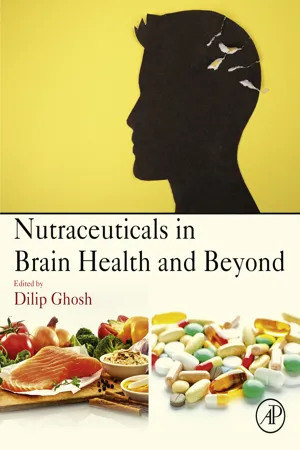Biological Sciences
Gut Brain Axis
The gut-brain axis refers to the bidirectional communication system between the gastrointestinal tract and the central nervous system. It involves the complex interplay of neural, hormonal, and immunological signaling pathways. This axis plays a crucial role in regulating various physiological processes, including digestion, metabolism, and even cognitive functions.
Written by Perlego with AI-assistance
Related key terms
Related key terms
1 of 4
Related key terms
1 of 3
9 Key excerpts on "Gut Brain Axis"
- eBook - ePub
- Daniel K. Podolsky, Michael Camilleri, J. Gregory Fitz, Anthony N. Kalloo, Fergus Shanahan, Timothy C. Wang, Daniel K. Podolsky, Michael Camilleri, J. Gregory Fitz, Anthony N. Kalloo, Fergus Shanahan, Timothy C. Wang(Authors)
- 2015(Publication Date)
- Wiley-Blackwell(Publisher)
Arguably, the most unequivocal evidence of the brain's influence on human GI function derives from reports of alterations of this function caused by lesions within the central nervous system (CNS). The most frequently encountered clinical example is dysphagia following a cerebrovascular accident [5]. A further example is gastric emptying delay occurring as a sequelae of spinal cord transection or constipation related to Parkinson disease [6,7]. Despite these insights, it was not until the late 1980s/early 1990s and the advent of the mainstream use of a number of noninvasive neurophysiological techniques, that these interactions have been studied noninvasively in vivo in health and disease. These technological developments have led to advances in our understanding of the sensorimotor pathways between the brain, the periphery, and the CNS. This increased understanding has led to the development of the concept of the brain–gut axis, a bidirectional communication between the gut and the brain, which has gained widespread acceptance as the construct providing an explanation of normal function, and acute and chronic perturbations, of GI function. Moreover, this model of bidirectional communication has provided a biological framework to underpin the biopsychosocial concept of GI disorders by facilitating the integration of many contributing factors whether they are biological, psychological, or social in nature.This chapter first reviews the salient functional anatomy and physiology of the brain–gut axis, and then examines the interactions of the brain–gut axis with the GI microbiome, appetite/satiety regulation, autonomic nervous system, and the hypothalamic–pituitary–adrenal (HPA) axis. Finally, alterations in the brain–gut axis and their clinical implications are considered.Gut to Brain Communication
Intrinsic Innervation – The Enteric Nervous System
The GI tract has substantial sensory innervation [8]. These sensory afferents convey information to the CNS, facilitating coordination and integration of reflex function with behavioral responses in addition to mediating sensation [9]. The intrinsic innervation of the GI tract, known as the enteric nervous system (ENS), can direct and sustain GI function even after connections to the CNS have been severed. As depicted in Figure 14.1 , the ENS comprises of the myenteric and submucosal plexi and controls gut motility, secretory and endocrine functions that are required for normal digestive processes (see Chapter 15 - eBook - ePub
- A. Halaris, B. E. Leonard(Authors)
- 2013(Publication Date)
- S. Karger(Publisher)
Copyright © 2013 S. Karger AG, BaselOver the past decade there has been an exponential increase in research focusing on the braingut axis because of its potential role in a variety of disorders, not just relating to irritable bowel syndrome and inflammatory bowel disease, but also involvement in mood disorders. In this review we will explore the impact of stress on the brain-gut axis and the possibility of targeting the axis for the treatment of stress related disorders such as depression.Studies of this brain-gut axis now of necessity include the gut microbiota, which in many respects is a metabolic organ in its own right. The general scaffolding of the brain-gut-enteric microbiota axis includes the central nervous system (CNS), the neuroendocrine and neuroimmune systems, the sympathetic and parasympathetic arms of the autonomic nervous system (ANS), the enteric nervous system (ENS) and the intestinal microbiota. These components interact to form a complex reflex network with afferent fibres that project to integrative CNS structures and efferent projections to the smooth muscle [1 ]. Through this bidirectional communication network, signals from the brain can influence the motor, sensory and secretory modalities of the gastrointestinal tract (GIT) and, conversely, visceral messages from the gut can influence brain function [1 ]. Less well studied but increasingly appreciated is the potential impact of the enteric microbiota on the relationships within the construct [2 , 3 ] and the realisation it may play a part in CNS disorders such as major depression.Microbiota Composition and Development
The GIT is inhabited with 1013 —1014 microorganisms, a figure thought to be ten times that of the number of human cells in our bodies and 150 times as many genes as our genome [4 , 5 ]. The estimated species number varies greatly but it is generally accepted that the adult microbiome consists of greater than 1,000 species [6 ] and more than 7,000 strains [7 ]. It is an environment dominated by bacteria, mainly strict anaerobes, but also including viruses, protozoa, archae and fungi [8 ]. The microbiome is largely defined by 2 bacterial phylotypes, Bacteroidetes and Firmicutes with Proteobacteria, Actinobacteria, Fusobacteria , and Verrucomicrobia phyla present in relatively low abundance [9 - Available until 20 Sep |Learn more
Lactic Acid Bacteria
Microbiological and Functional Aspects
- Gabriel Vinderola, Arthur Ouwehand, Seppo Salminen, Atte von Wright, Gabriel Vinderola, Arthur Ouwehand, Seppo Salminen, Atte von Wright, Gabriel Vinderola, Arthur Ouwehand, Seppo Salminen, Atte von Wright(Authors)
- 2019(Publication Date)
- CRC Press(Publisher)
13–14 bacteria that reside in our gut are now believed to be a vital node in the communication pathway with the emergence of an updated term, “the microbiome–gut–brain axis” (MGB axis) (Cryan and O’Mahony, 2011). While our gut bacteria have historically been regarded as commensal organisms, it is increasingly recognized that their relationship with the host is actually a symbiotic one, impacting the functioning of virtually all organ systems, not least of all the CNS. Could our microbiome hold an etiological, or even therapeutic, key to the mood and anxiety disorders that are epidemic in today’s Western world? Could our mutualistic gut bacteria play a protective role in maintaining psychological health and possibly have the potential to alleviate depressive symptoms or cognitive dysfunction? The implications of our new understanding of the human being as a “superorganism” are only beginning to be realized.28.2 POTENTIAL MECHANISMS BY WHICH THE MICROBIOME AFFECTS CNS FUNCTIONSeveral approaches have been used preclinically to elucidate the effects of the gut microbiome on the brain and behavior. These include the use of germ-free (GF) animals, animals exposed to probiotics, prebiotics, pathogenic bacterial infections or antibiotics, and fecal microbiome transplantation (FMT). The microbiome appears to play a role in modulating a wide range of systems including the hypothalamic–pituitary–adrenal (HPA) axis and stress response, the immune system, neurotransmission, tryptophan metabolism, and serotonin synthesis, all processes which are highly relevant to the regulation of mood and cognition. - eBook - ePub
A Comprehensive Overview of Irritable Bowel Syndrome
Clinical and Basic Science Aspects
- Jakub Fichna(Author)
- 2020(Publication Date)
- Academic Press(Publisher)
3: Irritable bowel syndrome and the brain-gut connection
Leon Pawlik; Aleksandra Tarasiuk Department of Biochemistry, Faculty of Medicine, Medical University of Lodz, Lodz, PolandAbstract
The brain-gut axis (BGA) is a complex, bidirectional communication system between enteric nervous system and central nervous system and in healthy organism it is an essential pathway in regulating the proper functioning of the gastrointestinal tract. Main manifestations of irritable bowel syndrome (IBS) such as abdominal pain, bloating and abnormal bowel movements can be understood as a disruption in BGA. Stress, strong emotional experiences or altered intestinal microbiota can affect BGA and therefore modulate the bowel motility, secretion and visceral sensibility. In this chapter we will discuss as well as describe constituents of the BGA and their connections with IBS.Keywords
Brain-gut axis; BGA; Irritable bowel syndrome (IBS); Functional gastrointestinal disorder; Microbiota-gut-brain axisList of abbreviations5-HT 5-hydroxytryptamine; serotoninACC anterior cingulate cortexACTH adrenocorticotropic hormoneANS autonomic nervous systemBGA brain-gut axisCNS central nervous systemCRH corticotrophin-releasing hormoneEC enterochromaffin cellsGABA gamma aminobutyric acidGI gastrointestinalGM gut microbiotaHPA hypothalamic-pituitary-adrenal (axis)IBS irritable bowel syndromeIBS-C constipation-predominant irritable bowel syndromeIBS-D diarrhea-predominant irritable bowel syndromeMC mast cellsMBGA microbiota-brain-gut axisSCFAs short chain fatty acidsVH visceral hypersensitivityIntroduction
Irritable bowel syndrome (IBS) is one of the most common functional gastrointestinal (GI) disorders and among the most frequent causes of gastroenterology consultations [1] . Despite the high prevalence (about 10% of the world population), the pathogenesis of IBS is still not fully understood. Main pathophysiological mechanisms are: altered GI motility, visceral hypersensitivity, increased intestinal permeability, brain-gut axis (BGA) dysregulation and changes in the intestinal microbiota. These changes in turn contribute to the main manifestations of IBS such as abdominal pain, bloating and abnormal bowel function (diarrhea and/or constipation) [2] . Psychosocial factors can also influence digestive function, symptom perception, illness behavior and outcome. Conversely, visceral pain affects central pain perception, mood and behavior. IBS may be perceived as a disorder resulting at least in part from disruption of BGA [3] . More recently, the role of the gut microbiota in the bidirectional communication along BGA, and subsequent changes in behavior, has emerged [4] - eBook - ePub
- P. J. D. Delhanty, A. J. van der Lely(Authors)
- 2014(Publication Date)
- S. Karger(Publisher)
There is a burgeoning appreciation that the gut microbiota can affect host health by impacting the central nervous system (CNS) through neural, endocrine, and immune pathways. The ‘gut-brain axis’ represents the bidirectional signalling between the brain and gastrointestinal (GI) tract responsible for maintaining homeostasis of the host through both neural and hormonal mechanisms.Gut Microbiota Alters the CNS Function and Host Behavior
Accumulating evidence demonstrates that the gut microbiota can influence CNS functions, hence the term ‘microbiota-gut-brain axis’. First, clinical studies demonstrate that patients with GI diseases, such as IBDs, exhibit an aberrant gut microbiota, which is sometimes associated with psychiatric disorders. Secondly, GF mice exhibit differences in anxiety behavior, motor control, and memory, which is associated with changes in brain chemistry. Likewise, mice strains with differences in exploratory behavior show alterations in gut microbiota. Finally, probiotic treatment normalizes host behavior such as anxiety as well as brain chemistry. This overwhelming evidence for a microbiota-gut-brain axis that has a strong influence on CNS function and overall host behavior provides credence to the idea that the gut microbiota can similarly alter CNS control of energy homeostasis by influencing intestinal nutrient signalling pathways.Gut-Brain Signalling in Control of Food Intake and Energy Regulation
Gut-brain signalling is important in the control of food intake and maintenance of normal glycemic levels. As such, the gut senses intestinal nutrients triggering a variety of signals, such as GI peptides, to provide feedback to the brain about both their quality and quantity. Short-term (or episodic) signals, which are released in response to eating, determine the size of the meal (e.g. CCK), and/or control the amount of time between meals (i.e. GLP-1, PYY), also termed satiation and satiety, respectively. These peptides can then act on local sensory nerves innervating the GI tract to relay messages to the hindbrain, or they can act in an endocrine fashion, directly activating receptors in the brain. Although known for their short-term role in energy intake, recent evidence, including rapid increases in GI peptide levels, now indicates a potential long-term role in the maintenance of body weight and development of obesity [see 24 - eBook - ePub
Stress: Genetics, Epigenetics and Genomics
Volume 4: Handbook of Stress
- George Fink(Author)
- 2020(Publication Date)
- Academic Press(Publisher)
Chapter 12: Molecular Signaling in the Gut–Brain Axis in Stress
Amanda J. Pagea , b ; Hui Lia , ba Vagal Afferent Research Group, Adelaide Medical School, University of Adelaide, Adelaide, SA, Australiab Nutrition, Diabetes & Gut Health, Lifelong Health Theme, South Australian Health and Medical Research Institute, Adelaide, SA, AustraliaAbstract
The bidirectional communication between the gastrointestinal tract (GI) and the brain is termed the gut–brain axis. It involves endocrine and neural pathways (parasympathetic nerves and sympathetic nerves) and interactions with the GI immune system and the gut microbiota. The gut–brain axis plays a crucial role in the modulation of the physiological functioning of the GI tract and the brain. This complex communication system is extremely sensitive to stress. In response to stress the molecular signaling in the gut–brain axis can be altered, in both descending and ascending pathways. The alterations can be adaptive responses, allowing the body to cope with environmental threats and maintain homeostasis. However, it can also lead to malfunctions in the GI tract and brain contributing to the development of many GI and brain associated disorders. - eBook - ePub
- A. Halaris, B. E. Leonard(Authors)
- 2017(Publication Date)
- S. Karger(Publisher)
Halaris A, Leonard BE (eds): Neuroprogression in Psychiatric Disorders.Mod Trends Pharmacopsychiatry. Basel, Karger, 2017, vol 31, pp 152–161 (DOI: 10.1159/000470813) ______________________The Brain-Gut Axis Contributes to Neuroprogression in Stress-Related Disorders
Kieran Reaa · Timothy G. Dinana , b · John F. Cryana , ca APC Microbiome Institute and Departments of b Psychiatry and Neurobehavioural Science and c Anatomy and Neuroscience, University College Cork, Cork, Ireland______________________Abstract
There is a growing emphasis on the relationship between the complexity and diversity of the microorganisms that inhabit our gut (human gastrointestinal microbiota) and brain health. The microbiota-gut-brain axis is a dynamic matrix of tissues and organs including the brain, glands, gut, immune cells, and gastrointestinal microbiota that communicate in a complex multidirectional manner to maintain homeostasis. Changes in this environment may contribute to the neuroprogression of stress-related disorders by altering physiological processes including hypothalamic-pituitary-adrenal axis activation, neurotransmitter systems, immune function, and inflammatory responses. While appropriate, coordinated physiological responses, such as immune or stress responses, are necessary for survival, the contribution of repeated or chronic exposure to stress may predispose individuals to a more vulnerable state leaving them more susceptible to stress-related disorders. In this chapter, the involvement of the gastrointestinal microbiota in stress- and immune-mediated modulation of neuroendocrine, immune, and neurotransmitter systems and the consequential behavior is considered. We also focus on the mechanisms by which commensal gut microbiota can regulate neuroinflammation and further aim to exploit our understanding of their role in the effects of the microbiota-gut-brain axis on the neuroprogression of stress-related disorders as a consequence of neuroinflammatory processes. - eBook - ePub
Neurobiology of Bipolar Disorder
Road to Novel Therapeutics
- Joao Quevedo, Andre Ferrer Carvalho, Eduard Vieta, Joao L. de Quevedo(Authors)
- 2020(Publication Date)
- Academic Press(Publisher)
21 ].Given the known interrelationship between the gastrointestinal tract and the central nervous system, researchers initially developed the concept of brain-gut axis [22] , which has lately been extended to microbiota-gut-brain axis (MGBA) [23] due to the influence of gut microbiota on behavior and cognition, suggesting the existence of a connection between gut microbiota, brain, and neuropsychiatric disorders, including mood disorders as bipolar disorder (BD) [24] .The aim of this chapter is to summarize the different pathways by which the gut microbiota can modulate brain functions, review the impact of MGBA on BD, and expose future potential therapeutic targets based on the modulation of this axis.The microbiota-gut-brain axis
Bidirectional interaction between brain and gut microbiota is integrated in the microbiota-gut-brain axis (MGBA), which consists of a combination of neural, endocrine, immune, metabolic, and cellular pathways that interact among them in a synergic manner (Fig. 1 ).Fig. 1 Bidirectional modulation of the microbiota-gut-brain axis (MGBA). Stress (1 ) activates the HPA axis, increasing circulating levels of (2 ) cortisol that (3 ) changes commensal bacteria’s composition (dysbiosis) (4 ) inducing an increase of epithelial permeability and facilitating the entrance of enteric pathogens. This disruption of the intestinal barrier is called leaky gut. (5 ) Microbiota can also participate in the regulation of neuroendocrine cells. “Leaky gut” contributes to (6a ) translocation of metabolic products generated by the microbiota (SCFA, TRP, NA, GABA, and 5-HT) and (6b ) bacterial translocation. Mimetic structure of bacterial wall with components of the brain may elicit (7 ) autoimmune response against brain. Besides, bacterial translocation can (8 ) induce a systemic immune and inflammatory response, increasing plasma levels of IL-1, IL-6, TNF-α, and INF-y. (9 ) TNF-α and IFN-y stimulate the activation of IDO, which (10 ) converts TRP to KYNA (an agonist of NMDAr). (11 ) TNF-α may also provoke HPA-axis activation and, together with INF-y and (12 ) O&NS, originated due to systemic inflammation, may harm both the brain and the epithelial barrier. Lastly, gut microbiota can modulate brain functions by (13 ) neural connections involving the central and the autonomic nervous system (SNA) (including the enteric nervous system [ENS]). Simultaneously, CNS communicates along both afferent and efferent autonomic pathways (SNA) with different intestinal targets such as ENS, muscle layers and gut mucosa, modulating motility, immunity, permeability, and secretion of mucus; this effect is partially mediated by (14 ) mast cells. 5-HT , serotonin; ACTH , adrenocorticotropic hormone; CRH , corticotropin-releasing hormone; CNS , central nervous system; DA , dopamine; GABA , ƴ-aminobutyric acid; HPA , hypothalamic-pituitary-adrenocortical axis; IDO , indoleamine-2,3-dioxygenase; IL-2 , interleukin-2; IL-6 , interleukin-6; INF-ƴ , interferon-ƴ; KYNA - eBook - ePub
- Dilip Ghosh(Author)
- 2020(Publication Date)
- Academic Press(Publisher)
The brain-gut axis: a target for treating stress-related disorders .Mod. Trends Pharmacopsychiatry. 2013;28:90–99.24 . . Arentsen T, Raith H, Qian Y, Forssberg H, Diaz Heijtz R. Host microbiota modulates development of social preference in mice .Microb Ecol Health Dis. 2015;26:29719.25 . . Lee Y.K, Menezes J.S, Umesaki Y, Mazmanian S.K. Proinflammatory T-cell responses to gut microbiota promote experimental autoimmune encephalomyelitis .Proc Natl Acad Sci USA. 2011;108(Suppl. 1):4615–4622.26 . . Agusti A, García-Pardo M.P, López-Almela I, Campillo I, et al. Interplay between the gut-brain Axis, obesity and cognitive function .Front Neurosci. 2018;12:155.27 . . Grenham S, Clarke G, Cryan J.F, Dinan T.G. Braingut- microbe communication in health and disease .Front Physiol. 2011;2:94.28 . . Browning K.N, Travagli R.A. Central nervous system control of gastrointestinal motility and secretion and modulation of gastrointestinal functions .Comp Physiol. 2014;4:1339–1368.29 . . Foster J.A, Rinaman L, Cryan J.F. Stress & the gutbrain axis: regulation by the microbiome .Neurobiol Stress. 2017;7:124–136.30 . . Kihara N, Fujimura M, Yamamoto I, Itoh E, Inui A, Fujimiya M. Effects of central and peripheral urocortin on fed and fasted gastroduodenal motor activity in conscious rats .Am J Physiol Gastrointest Liver Physiol. 2001;280:G406–G419.31 . . Czimmer J, Million M, Taché Y. Urocortin 2 acts centrally to delay gastric emptying through sympathetic pathways hile CRF and urocortin 1 inhibitory actions are vagal dependent in rats .Am J Physiol Gastrointest Liver Physiol. 2006;290:G511–G518.32 . . Söderholm J.D, Yates D.A, Gareau M.G, Yang P.C, et al. Neonatal maternal separation predisposes adult rats to colonic barrier dysfunction in response to mild stress .Am J Physiol Gastrointest Liver Physiol. 2002;283:G1257–G1263.33 . . Zheng G, Wu S.P, Hu Y, Smith D.E, Wiley J.W, Hong S. Corticosterone mediates stress-related increased intestinal permeability in a region-specific manner
Index pages curate the most relevant extracts from our library of academic textbooks. They’ve been created using an in-house natural language model (NLM), each adding context and meaning to key research topics.
Explore more topic indexes
Explore more topic indexes
1 of 6
Explore more topic indexes
1 of 4








